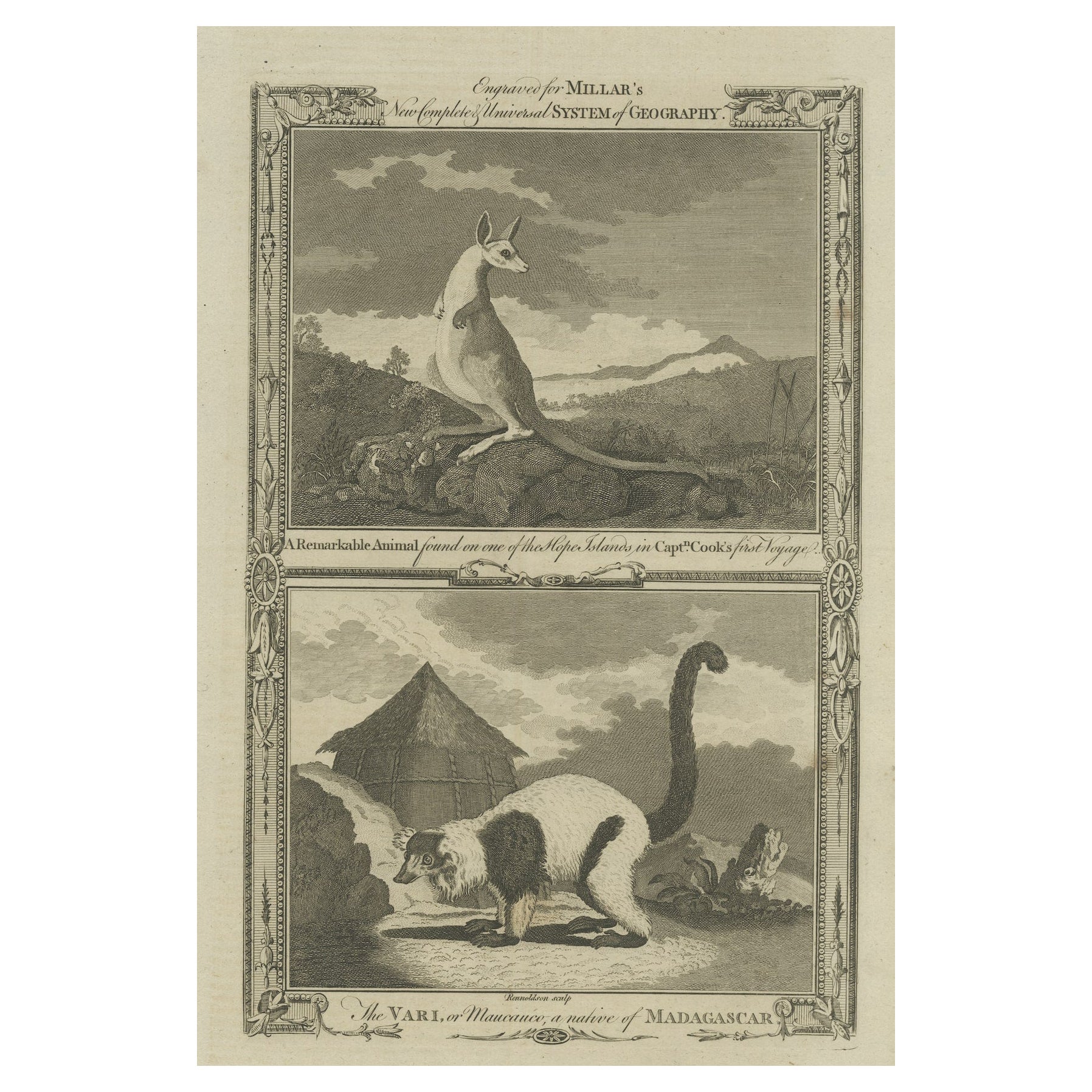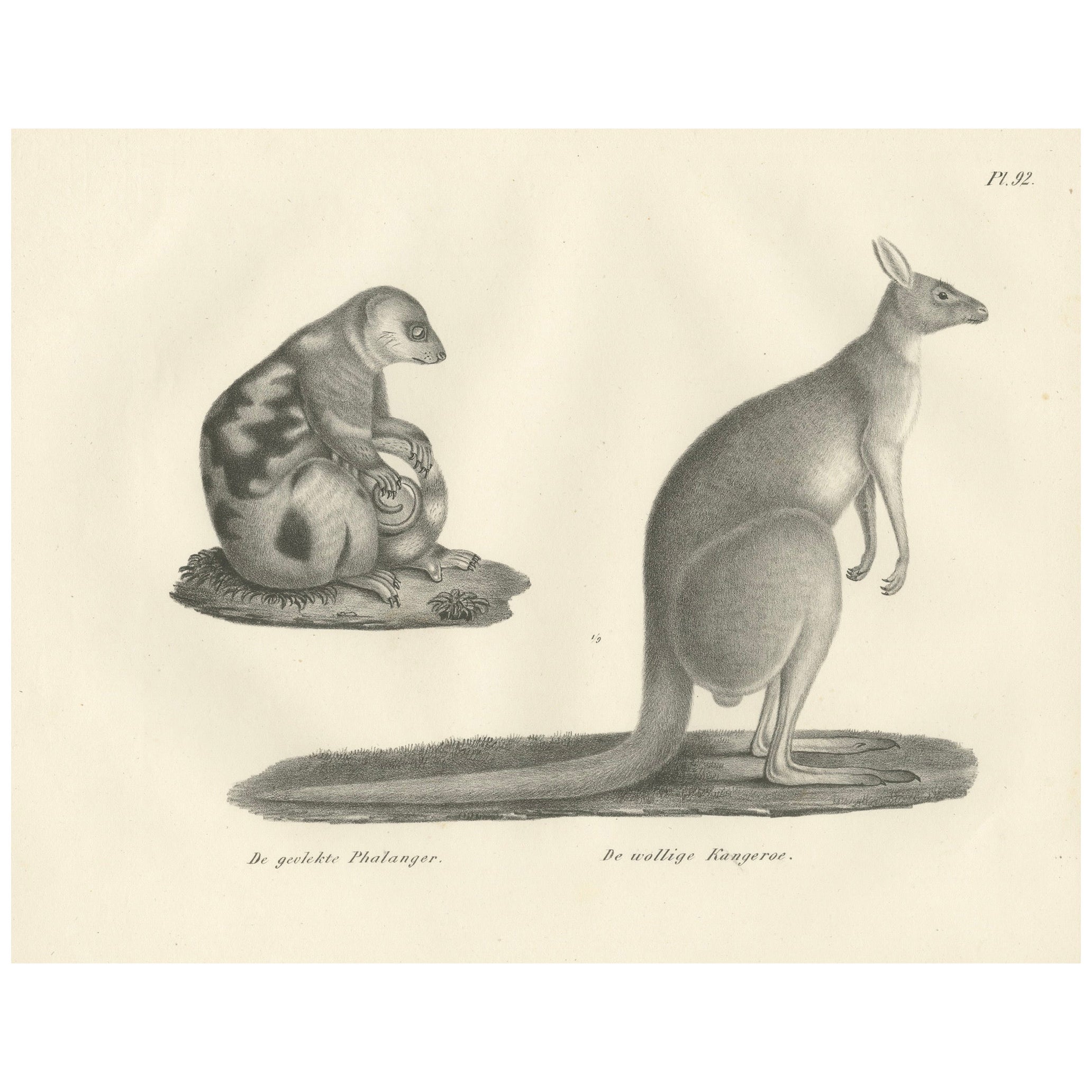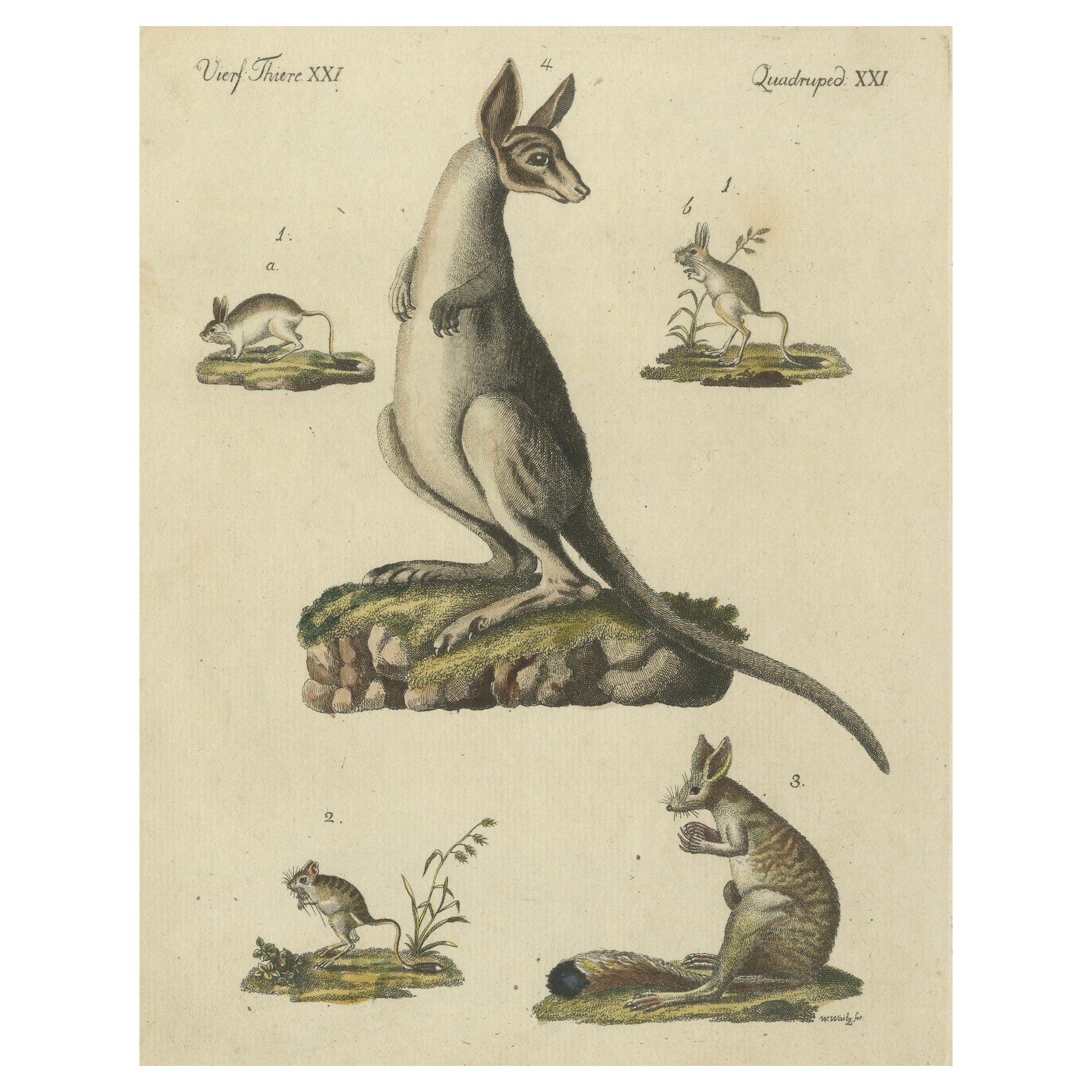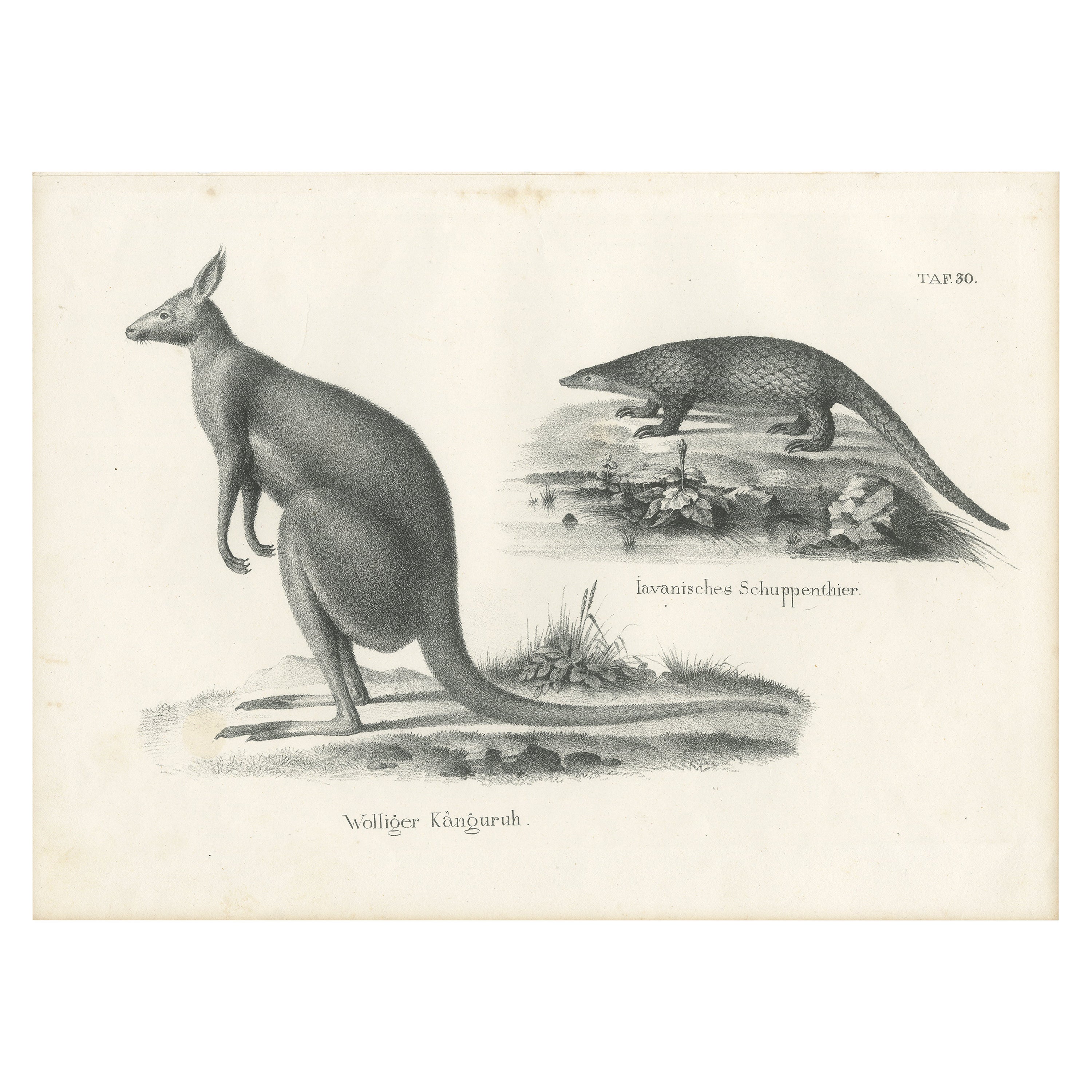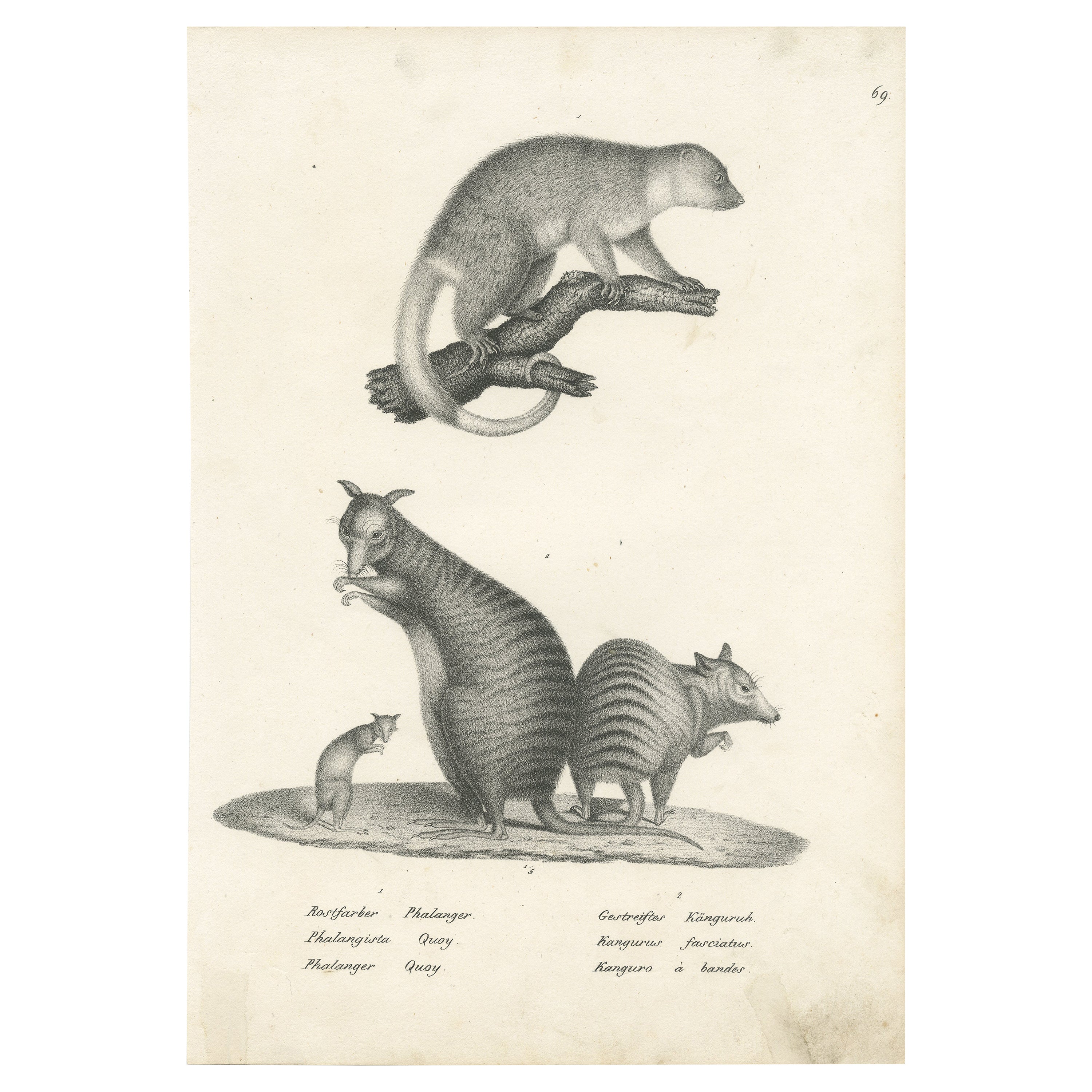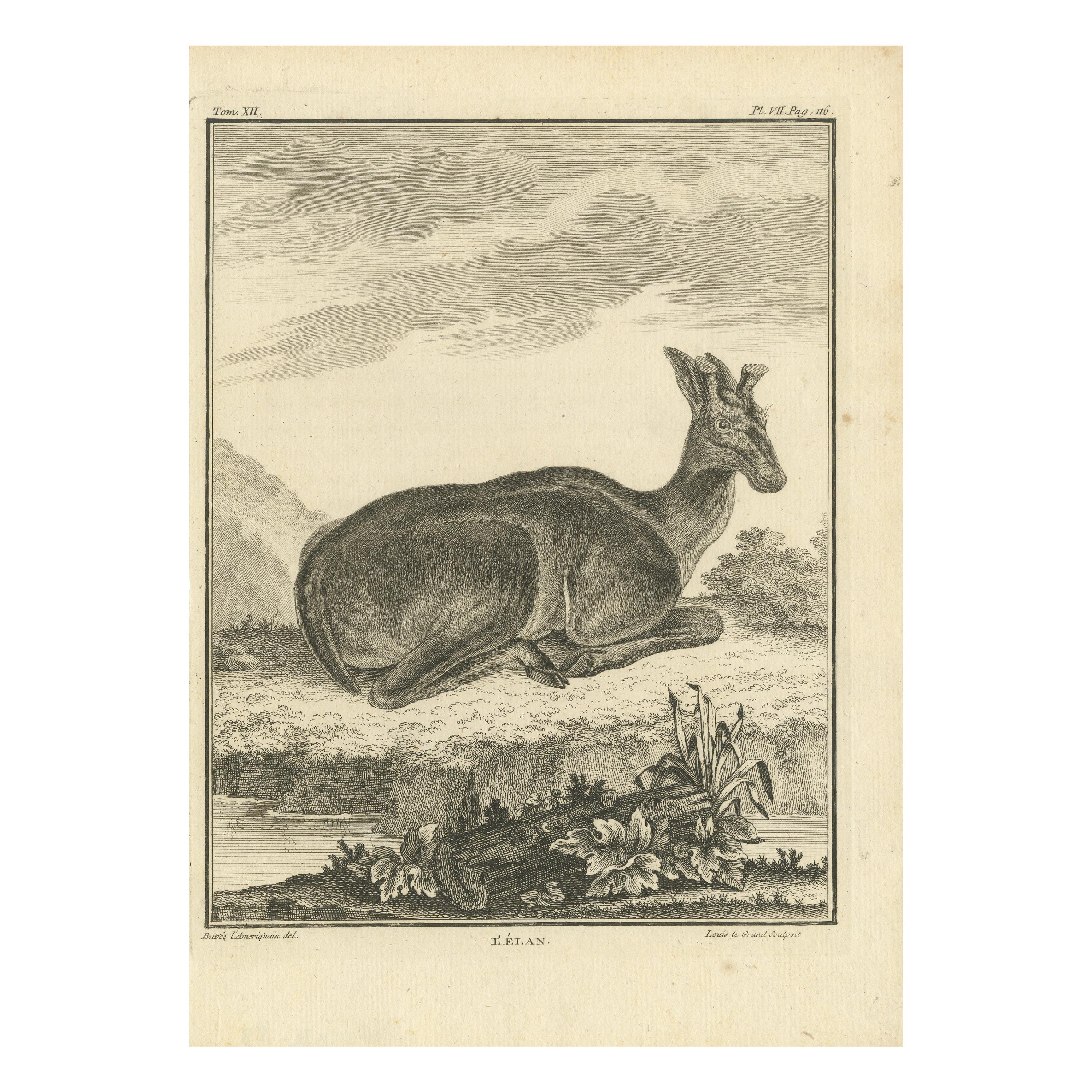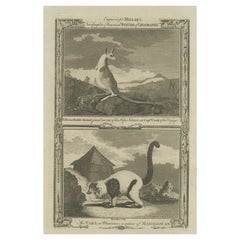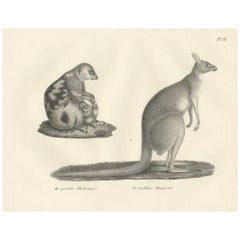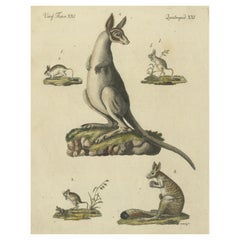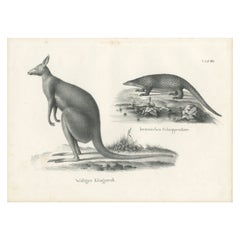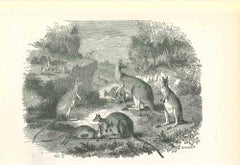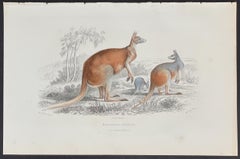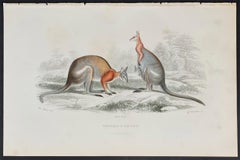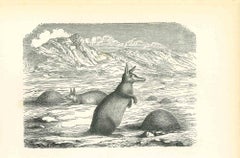Items Similar to Antique Copper Engraving of a Kangaroo in Australia, 1744
Want more images or videos?
Request additional images or videos from the seller
1 of 6
Antique Copper Engraving of a Kangaroo in Australia, 1744
$278.21
$347.7620% Off
£206.96
£258.7020% Off
€232
€29020% Off
CA$380.96
CA$476.2020% Off
A$423.58
A$529.4820% Off
CHF 221.17
CHF 276.4620% Off
MX$5,156
MX$6,44520% Off
NOK 2,822.03
NOK 3,527.5420% Off
SEK 2,644.11
SEK 3,305.1420% Off
DKK 1,766.09
DKK 2,207.6120% Off
Shipping
Retrieving quote...The 1stDibs Promise:
Authenticity Guarantee,
Money-Back Guarantee,
24-Hour Cancellation
About the Item
The title 'Quadrupede Nomme Kanguroo, Trouve sur la Cote de la N'le Hollande' refers to an uncolored engraving depicting a Kangaroo, originally found and described during Captain Cook's first voyage, later rendered by George Stubbs in the English account. This French version offers a portrayal of the Kangaroo encountered on the coast of New Holland (Australia) during that expedition.
The Kangaroo illustration, an integral part of the narrative from Cook's exploration, became renowned due to its significance in the documentation of newly discovered fauna. George Stubbs, a celebrated artist, interpreted and immortalized this image in the English account of Cook's voyage.
This uncolored engraving presents a historical representation of the Kangaroo, an iconic symbol of Australia's unique wildlife, as observed and documented during a pivotal period of exploration. The illustration stands as a testament to the scientific curiosity and documentation prevalent during early voyages of discovery, contributing to the understanding and documentation of the natural world in the 18th century.
The print is in good condition, considering its age, but does have a few slightly visible vertical creases and some soiling. Nevertheless a very representable print of a few hunderd years old (1744).
Description:
This engraving is based on the first illustration of a “Kangaroo” an Australian species, drawn by George Stubbs from a specimen collected at Endeavour River in 1770 by James Cook’s crew while the Endeavour was being careened and issued in the official accounts of the voyage of the Endeavour. This iconic image captured the public’s imagination for over sixty years and was the first depiction of any Australian animal in western art. Confusion exists as to the original species described, based on the specimens brought back by Cook and the subsequent painting by Stubbs. This situation arose in the comparisons of drawings and photographs which are the only records of the lost original specimens, with Parkinson’s sketch made on 23rd June 1770 at Endeavour River and the later Stubbs painting. Parkinson’s sketches and paintings of natural history subjects held in public institutions, clearly show a prodigious artistic talent, and his sketch of a kangaroo made on the spot, is certainly a more realistic depiction than the later version painted by Stubbs that has exaggerated features. Stubbs had the disadvantages of not seeing a live animal and only having the dried skin that was brought back by Cook to work from. It is probable that the skin was firstly re-hydrated and then inflated for Stubbs to be able paint the animal. It has been established that the kangaroos collected on Cook’s expedition near Cooktown were specimens of the Grey Kangaroo, Macropus giganteus (Roland Strachan CBOM p.244).
The first sighting of a kangaroo in fact was an earlier one, by Francis Pelsaert of “the teeming cats” on 15th November, 1629 on the Abrolhos Islands where the Batavia had been wrecked.
The first illustration of a Macropod was made prior to the Stubbs illustration, titled ‘Kangaron’ and made on 15th November 1629 by Matthys Pool and described by Cornelis de Bruyn in Reizen over Moskovie door Persie en Indie, 1714 but the animal depicted was not an Australian species but Thylogale brunii (Dusky Pademelon), a Filander native to New Guinea.
From Cook’s published accounts Endeavour River Qld First sighting of a Kangaroo 22 June 1770 Joseph Banks;
‘The People who were sent to the other side of the water in order to shoot Pigeons saw an animal as large as a grey hound, of a mouse colour and very swift..’
Cook sees a kangaroo 24 June 1770 James Cook;
‘I saw my self this morning a little way from the ship one of the Animals before spoke off, it was of a light Mouse colour and the full size of a grey hound and shaped in every respect like one’.
The animal named 4 August 1770 James Cook;
‘the Animal which I have before mentioned is called by the natives Kangooroo or Kanguru.
In a study made by W.E.Ling-Roth of the north-west central Queensland Aborigines in 1897, he found that there might have been confusion with the word ‘ganguru’ which meant simply ‘don’t understand your question’. The spelling ‘kanguroo’ prevailed for nearly half a century until the modern version became the standard.
References Lennox-boyd George Stubbs 1989 pg 138 plate 35.III, Hawkesworth An account of the Voyages, 1773 Plate 20, Younger Kangaroo Images Through.. 1988 Pg 47 ill. Pg 46.
George Stubbs (1724 - 1806)
Stubbs was classified in his lifetime as a sporting painter, and as such was excluded from full membership of the Royal Academy. He is best remembered for his paintings of horses and his conversation pieces. Having studied anatomy, Stubbs's pictures of horses are among the most accurate ever painted. Stubbs was born in Liverpool, the son of a leather worker, and he spent his early career painting portraits and developing his interest in anatomy. In the 1740s he lived in York and supplied the illustrations for a treatise on midwifery. Following a brief visit to Rome in 1754, he settled in Lincolnshire, where he researched his major publication, The Anatomy of the Horse. In about 1758 he moved to London, which remained his base. Early clients for his sporting and racing paintings included many of the noblemen who founded the Jockey Club. Like Gainsborough, he later painted scenes of peasant life, as well as studies of wild and exotic animals. He also became known as a printmaker and for his paintings in enamel on Wedgwood earthenware plaques.
- Dimensions:Height: 9.85 in (25 cm)Width: 7.49 in (19 cm)Depth: 0 in (0.02 mm)
- Materials and Techniques:
- Period:1740-1749
- Date of Manufacture:1744
- Condition:Wear consistent with age and use. Good. Soiling due to age and handling. Brown spot on the middle right. Study the image carefully.
- Seller Location:Langweer, NL
- Reference Number:Seller: BG-13059-41stDibs: LU3054326299672
About the Seller
5.0
Recognized Seller
These prestigious sellers are industry leaders and represent the highest echelon for item quality and design.
Platinum Seller
Premium sellers with a 4.7+ rating and 24-hour response times
Established in 2009
1stDibs seller since 2017
2,511 sales on 1stDibs
Typical response time: <1 hour
- ShippingRetrieving quote...Shipping from: Langweer, Netherlands
- Return Policy
Authenticity Guarantee
In the unlikely event there’s an issue with an item’s authenticity, contact us within 1 year for a full refund. DetailsMoney-Back Guarantee
If your item is not as described, is damaged in transit, or does not arrive, contact us within 7 days for a full refund. Details24-Hour Cancellation
You have a 24-hour grace period in which to reconsider your purchase, with no questions asked.Vetted Professional Sellers
Our world-class sellers must adhere to strict standards for service and quality, maintaining the integrity of our listings.Price-Match Guarantee
If you find that a seller listed the same item for a lower price elsewhere, we’ll match it.Trusted Global Delivery
Our best-in-class carrier network provides specialized shipping options worldwide, including custom delivery.More From This Seller
View AllAntique Engravings of an Australian Kangaroo and a Vari of Madagascar, c.1780
Located in Langweer, NL
Engraving by Rennoldson (18th Century British School) with nice decorative border.
1) A Remarkable Animal Found on One of the Hope Islands in Capt Cook's First Voyage.
2) The Va...
Category
Antique 1770s Prints
Materials
Paper
$182 Sale Price
20% Off
19th-Century Lithograph of a Spotted Phalanger and Woolly Kangaroo of Australia
Located in Langweer, NL
19th-Century Lithograph of a Spotted Phalanger and Woolly Kangaroo from Australia
Description: This stunning 19th-century lithograph presents two fascinating marsupials native to...
Category
Antique 1830s Prints
Materials
Paper
Antique Handcolored Engraving of Kangaroo, Jerboas, and Bilby, c.1800
Located in Langweer, NL
Antique Handcolored Engraving of Kangaroo, Jerboas, and Bilby, Quadruped XXI, c.1800
This original handcolored copperplate engraving depicts various marsupials and small mammals,...
Category
Antique Early 1800s Prints
Materials
Paper
Antique Print of Kangaroo and a 'Javanese' Pangolin in Australia, c.1825
Located in Langweer, NL
A antique print depicting a 'Wolliger Kanguruh' (a kangaroo) and a 'Iavanisches Schuppenthier' (a Pangolin, a scaly anteater) from a German publication around 1825-1830.
Heinri...
Category
Antique 1820s Prints
Materials
Paper
Antique Print Showing the Phalanger and the Striped Kangaroo in Australia, 1825
Located in Langweer, NL
This original antique print originates from 'Naturgeschichte Abbildungen der Saugethiere' by H. R. Schinz, published by J. F. Schleijer c.1825. This work on mammals was part of a ser...
Category
Antique 1820s Prints
Materials
Paper
Antique Print of a Moose by Buffon '1769'
Located in Langweer, NL
Antique print titled 'L'Élan'. Original antique print of a moose. This print originates from 'Histoire naturelle, générale et particulière (..)'. Published 1769.
Category
Antique Late 18th Century Prints
Materials
Paper
$143 Sale Price
20% Off
You May Also Like
The Kangaroos - Original Lithograph by Paul Gervais - 1854
By Paul Gervais
Located in Roma, IT
The Kangaroos is an original lithograph on ivory-colored paper, realized by Paul Gervais (1816-1879). The artwork is from The Series of "Les Trois Règnes de la Nature", and was publi...
Category
1850s Modern Figurative Prints
Materials
Lithograph
Kangaroo - Australia - Georges Louis Leclerc, Comte de Buffon C. 1820
By Georges-Louis Leclerc, Comte de Buffon
Located in BRUCE, ACT
This originally hand-colored engraving is from Georges Louis Leclerc comte de Buffon's Oeuvres complètes de Buffon. Nouvelle édition annotée et pr...
Category
Early 18th Century Animal Prints
Materials
Engraving
Kangaroo - Australia - Georges Louis Leclerc, Comte de Buffon C. 1820
By Georges-Louis Leclerc, Comte de Buffon
Located in BRUCE, ACT
This originally hand-colored engraving is from Georges Louis Leclerc comte de Buffon's Oeuvres complètes de Buffon. Nouvelle édition annotée et pr...
Category
Early 18th Century Animal Prints
Materials
Engraving
The Kangaroos - Lithograph by Paul Gervais - 1854
By Paul Gervais
Located in Roma, IT
The Kangaroos is an original lithograph on ivory-colored paper, realized by Paul Gervais (1816-1879). The artwork is from The Series of "Les Trois Règnes de la Nature", and was publi...
Category
1850s Modern Animal Prints
Materials
Lithograph, Paper
Kanguroo Dorsal - Original Lithograph by Paul Gervais - 1854
By Paul Gervais
Located in Roma, IT
Kanguroo Dorsal is an original lithograph on ivory-colored paper, realized by Paul Gervais (1816-1879). The artwork is from The Series of "Les Trois Règnes de la Nature", and was pub...
Category
1850s Modern Figurative Prints
Materials
Lithograph
Animal Figures for Antiquities - Original Etching - Mid-18th Century
Located in Roma, IT
Animal Figures for the Antiquities of Herculaneum Exposed, original etching from the mid-18th century, made by Various Old Masters.
In very good condition, except for some stains al...
Category
18th Century Old Masters Figurative Prints
Materials
Etching
